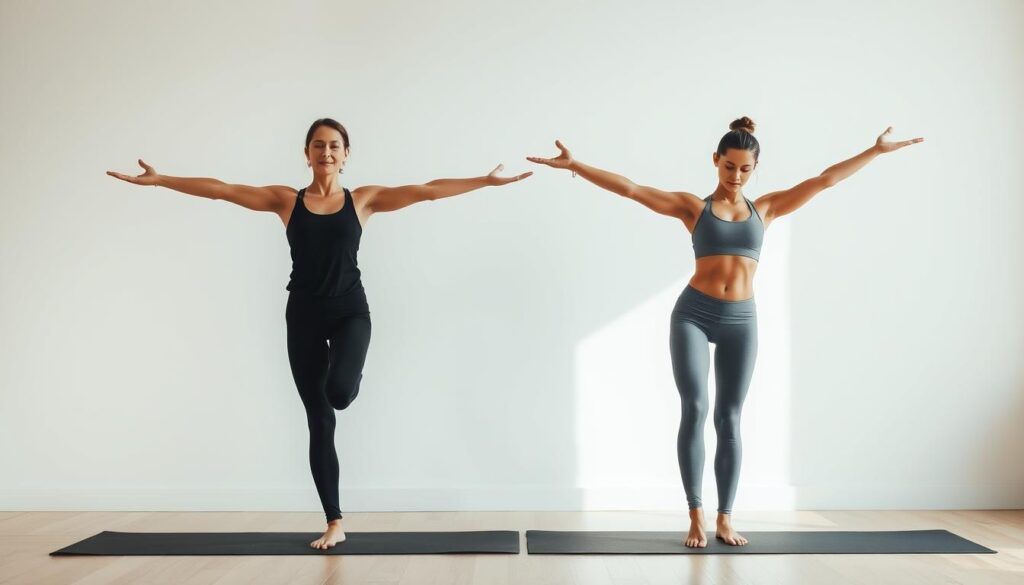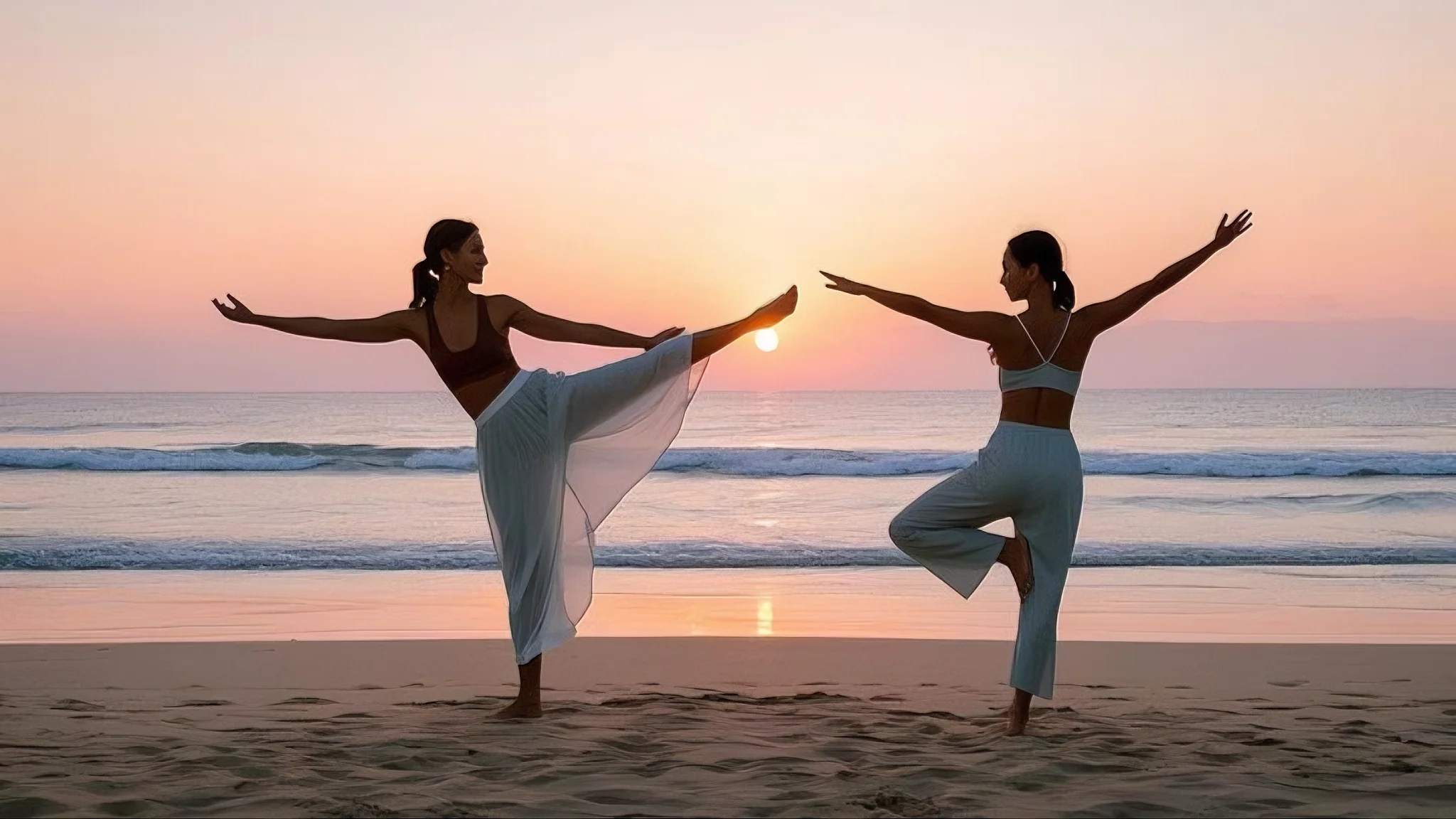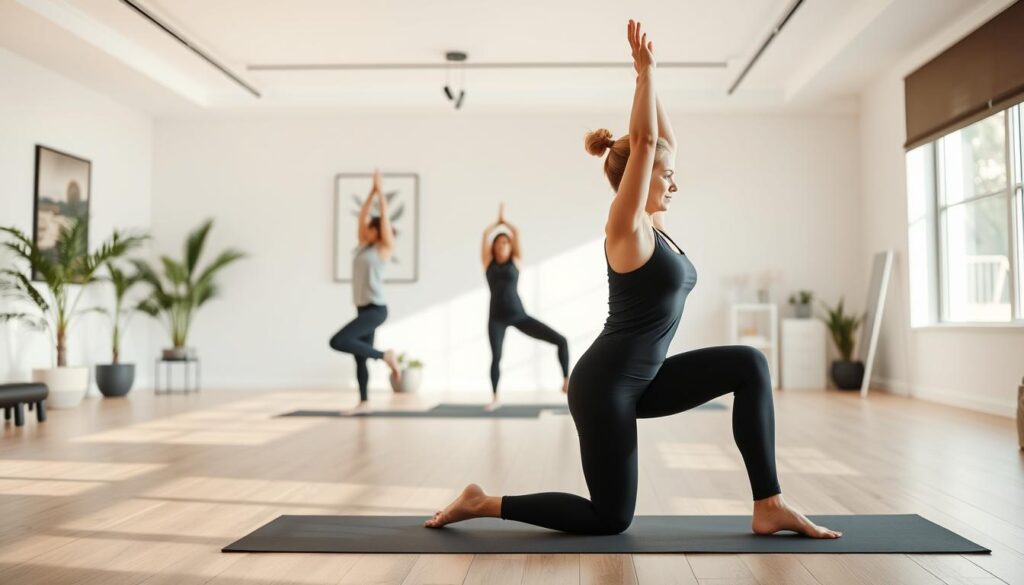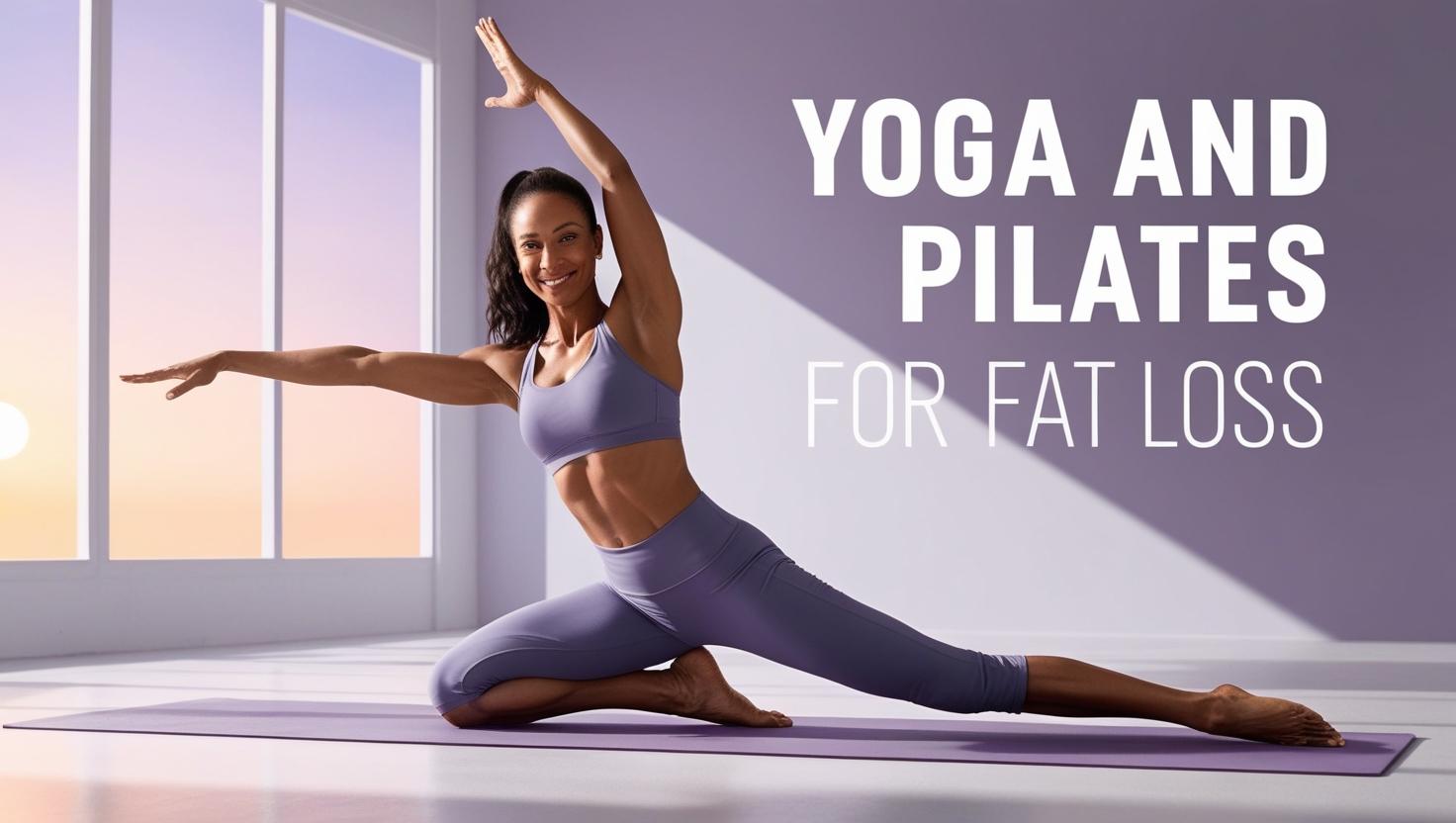Yoga and Pilates for Fat Loss
Did you know that a single Pilates class can burn up to 800 calories? That’s almost as much as a high-intensity workout! While yoga and Pilates are often seen as gentle practices, they pack a serious punch when it comes to fat loss and overall health.
Yoga, an ancient practice from India, focuses on mindfulness, flexibility, and strength. Pilates, developed by Joseph Pilates during WWI, emphasizes core strength and controlled movements. Both are low-impact exercises, making them perfect for anyone looking to improve their body without straining it.
This guide will show you how combining these two practices can help you shed fat, build muscle, and boost your overall health. Whether you’re holding a yoga pose or mastering a Pilates movement, you’ll be working toward a stronger, leaner you.
Ready to explore how these timeless practices can transform your body? Let’s get started!
Exploring the Origins and Philosophies of Yoga and Pilates
From ancient India to modern studios, yoga and Pilates have shaped fitness history. These practices may seem worlds apart, but their roots and philosophies reveal a shared focus on body, mind, and health.
Ancient Roots of Yoga and Its Mindful Tradition
Yoga began over 5,000 years ago in India. It’s more than just a physical practice—it’s a way of life. The word “yoga” means “union,” symbolizing the connection between body and mind.
Early yoga focused on mindfulness and meditation. Physical poses, or asanas, were added later to prepare the body for long periods of sitting. Today, yoga is a global phenomenon, with millions embracing its benefits for flexibility, strength, and stress relief.
“Yoga is the journey of the self, through the self, to the self.” – The Bhagavad Gita
The Evolution of Pilates from Rehabilitation to Fitness
Pilates, on the other hand, is a modern discipline. Developed by Joseph Pilates during WWI, it started as a rehabilitation method for injured soldiers. His goal was to improve core strength and overall body control.
Pilates later gained popularity among dancers and athletes in New York City. Its focus on precise movements and controlled breathing made it a favorite for improving posture and preventing injury.
Here’s a quick comparison of their foundational principles:
| Aspect | Yoga | Pilates |
|---|---|---|
| Origin | Ancient India | Early 20th Century |
| Focus | Mindfulness, Flexibility | Core Strength, Control |
| Breathing | Deep Belly Breathing | Lateral Thoracic Breathing |
Both practices have stood the test of time, offering unique ways to enhance fitness and well-being. Whether you’re drawn to yoga’s meditative flow or Pilates’ precision, there’s something for everyone.
Comparing Movement Strategies and Core Principles
Yoga flows like a river, while Pilates moves like a well-oiled machine. Both practices aim to improve your body and mind, but their approaches to movement are strikingly different. Whether you’re holding a yoga pose or mastering a Pilates technique, you’re building a stronger, more balanced you.

Flow, Breath, and the Mind-Body Connection in Yoga
Yoga is all about fluidity. Each pose transitions seamlessly into the next, guided by deep, rhythmic breathing. This practice emphasizes the mind-body connection, helping you relax and increase flexibility. For example, in a yoga class, you might flow from a downward dog to a warrior pose, syncing each movement with your breath.
Yoga’s focus on mindfulness also reduces stress and improves mental clarity. It’s like a moving meditation that leaves you feeling centered and refreshed. Whether you’re a beginner or an advanced practitioner, modifications make yoga accessible to everyone.
Core Stabilization and Precision in Pilates
Pilates, on the other hand, is all about precision. Every movement is controlled and deliberate, with a strong focus on core stabilization. This technique strengthens your muscles, improves posture, and reduces pain, especially in the back.
In a Pilates class, you might use specialized equipment like a Reformer to enhance your workout. Even mat-based Pilates emphasizes proper form and alignment, ensuring each movement targets the right muscles. It’s a low-impact exercise that builds strength without straining your joints.
| Aspect | Yoga | Pilates |
|---|---|---|
| Movement Style | Fluid, breath-centered | Precise, core-driven |
| Focus | Mind-body connection, flexibility | Core strength, posture |
| Breathing | Deep belly breathing | Lateral thoracic breathing |
| Equipment | Mat, blocks, straps | Reformer, resistance bands |
Both yoga and Pilates share a commitment to deliberate breathing techniques, which enhance focus and effectiveness. Whether you prefer the flowing style of yoga or the structured approach of Pilates, both practices offer unique benefits for your fitness journey. For more insights, check out this guide on comparing Pilates and yoga techniques.
The Science Behind Fat Loss with yoga-and-pilates Practices
Science shows that yoga and Pilates are more than just stretching—they’re fat-burning powerhouses. These practices combine targeted movements, controlled breathing, and mindfulness to help you shed fat while improving overall health. Let’s break down how they work.
Enhancing Core Strength and Flexibility for Weight Loss
Both yoga and Pilates focus on building core strength, which is essential for fat loss. A strong core improves posture, reduces back pain, and increases overall stability. For example, Pilates exercises like the Hundred or Roll-Up target the abdominal muscles, while yoga poses like Plank and Boat Pose engage the entire core.
Flexibility also plays a key role. Improved flexibility allows for better movement efficiency, which can lead to more calories burned during workouts. Studies show that regular yoga practice can increase flexibility by up to 20% in just eight weeks. This makes everyday activities easier and more effective for fat loss.
Here’s how each practice approaches core work:
| Aspect | Yoga | Pilates |
|---|---|---|
| Core Focus | Engages core in dynamic poses | Isolates core with precise movements |
| Flexibility | Improves through stretching | Enhances through controlled motions |
| Posture | Promotes alignment in static poses | Builds posture through core stability |
Breathwork Techniques and Metabolic Benefits
Breathing isn’t just about staying alive—it’s a powerful tool for fat loss. Both yoga and Pilates emphasize controlled breathing techniques that boost metabolism and reduce stress. Yoga uses deep belly breathing to calm the mind and increase oxygen flow, while Pilates focuses on lateral thoracic breathing to engage the core and improve endurance.
Research shows that mindful breathing can lower cortisol levels, a hormone linked to fat storage. By reducing stress, these practices help your body burn fat more efficiently. Plus, better breathing means more energy for your workouts, making every session more effective.
“Breath is the bridge which connects life to consciousness.” – Thich Nhat Hanh

Whether you’re flowing through a yoga sequence or mastering a Pilates move, these practices offer unique ways to achieve fat loss. By combining core strength, flexibility, and breathwork, you’ll not only look better but feel better too.
Integrating Yoga and Pilates into Your Weight Loss Routine
Looking to shed fat while improving your overall fitness? Combining yoga and Pilates might be the perfect solution. These practices complement each other, offering a balanced approach to weight loss that strengthens your body and calms your mind.
Whether you’re a beginner or a seasoned fitness enthusiast, integrating these two methods can help you achieve your goals. The key is to tailor your routine to match your specific needs, whether it’s building strength, improving flexibility, or enhancing overall fitness.
Tailoring Practices to Match Your Fitness Goals
Every person is unique, and so are their fitness goals. If you’re aiming for increased strength, focus on Pilates exercises that target your core and build lean muscle. For improved flexibility, incorporate yoga poses like Downward Dog or Warrior II into your routine.
Here’s a quick guide to help you get started:
| Goal | Yoga Focus | Pilates Focus |
|---|---|---|
| Strength | Plank, Chair Pose | Hundred, Roll-Up |
| Flexibility | Forward Fold, Cobra Pose | Swan Dive, Spine Stretch |
| Balance | Tree Pose, Eagle Pose | Single Leg Circle, Side Kick |
Consistency is key. Start with a few sessions per week and gradually increase as your body adapts. If you’re unsure where to begin, consider joining a class or working with a certified instructor for personalized modifications.
For more insights on how yoga and Pilates for weight loss can transform your routine, check out this guide. Remember, the journey to a healthier you is about progress, not perfection.
Ensuring Safety and Optimizing Performance
Starting a new fitness routine can feel overwhelming, but with the right guidance, yoga and Pilates can be both safe and effective. Whether you’re a beginner or a seasoned practitioner, focusing on proper form and technique is key to avoiding injuries and getting the most out of your workout.

Proper Form, Instructor Guidance, and Modifications
One of the most important aspects of any exercise is maintaining proper form. In yoga, this means aligning your body correctly in each pose to prevent strain. For Pilates, it’s about controlled movements that engage your core without overloading your joints.
Working with a certified instructor can make a huge difference. They can provide personalized feedback and ensure you’re performing each movement safely. If you’re dealing with pain or an injury, don’t hesitate to ask for modifications. For example, using a block in yoga can make a pose more accessible, while adjusting the resistance on a Pilates machine can ease pressure on sensitive areas.
“The body achieves what the mind believes.” – Unknown
Here’s a quick guide to staying safe and effective:
| Focus | Yoga | Pilates |
|---|---|---|
| Form | Align body in poses | Engage core in movements |
| Modifications | Use blocks, straps | Adjust resistance, props |
| Instructor Role | Provide alignment tips | Ensure controlled motions |
Supportive equipment like a mat or resistance bands can also enhance your practice. If you’re practicing at home, ensure your space is clear and comfortable. For those in a studio, take advantage of the professional environment to refine your technique.
Monitoring your progress is another way to stay motivated. Keep track of how your strength and flexibility improve over time. Remember, safety and injury prevention are the foundation of a sustainable fitness journey. For more tips on how to improve balance and coordination, check out this guide.
Embracing Your Journey to a Healthier Body
Your path to a healthier body starts with small, consistent steps. Whether you’re flowing through a yoga sequence or mastering a Pilates move, these practices offer unique ways to build strength, improve flexibility, and reduce stress. Together, they create a balanced approach to fitness that benefits both your body and mind.
Remember, there’s no one-size-fits-all routine. Experiment with different class formats or routines to find what works best for you. A certified instructor can help tailor your practice to your goals, whether it’s building muscle, enhancing balance, or simply feeling better every day.
Celebrate each small victory along the way. Progress takes time, but with dedication, you’ll see results. Grab your mat, take a deep breath, and embrace the journey to a stronger, healthier you.
